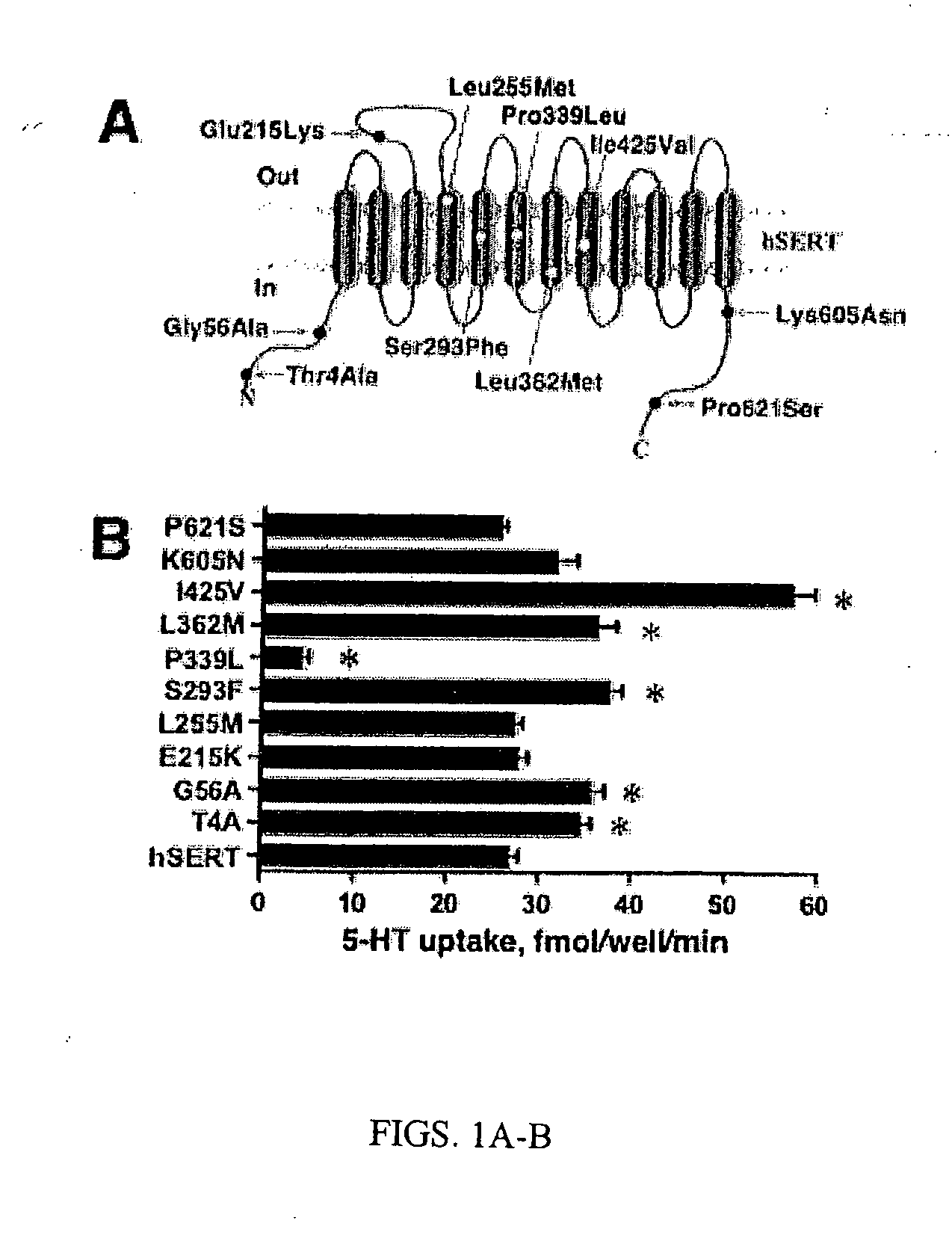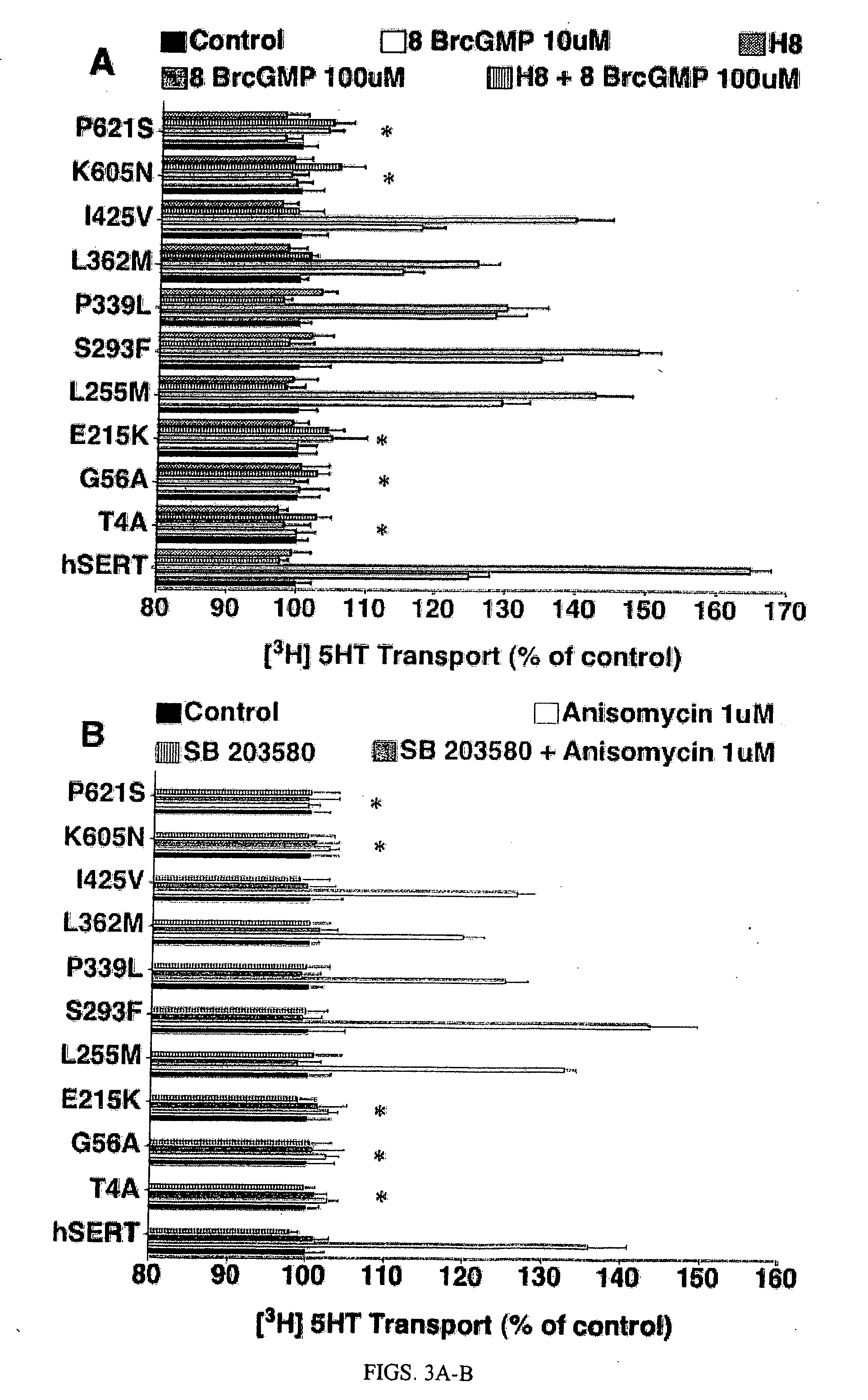Genetic and pharmacological regulation of antidepressant-sensitive biogenic amine transporters through PKG/p38 map kinase
a biogenic amine transporter and map kinase technology, applied in the field of neurology, pharmacology and psychiatry, can solve the problems of inefficient biosynthetic progression or rerouting to degradative pathways
- Summary
- Abstract
- Description
- Claims
- Application Information
AI Technical Summary
Benefits of technology
Problems solved by technology
Method used
Image
Examples
example 1
Materials & Methods
[0267] DNA Constructs. The full-length cDNA encoding hSERT in the mammalian expression vector pcDNA3.1 (Invitrogen) has been previously described (Qian et al., 1997). Mutations in hSERT were producing using the QuikChange mutagenesis kit (Stratagene). All mutations were confirmed by fluorescent dideoxynucleotide sequencing (Center for Molecular Neuroscience Neurogenomics Core).
[0268] Transfection and Transport Studies. HeLa cells, maintained at 37° C. in a 5% CO2 humidified incubator, were grown in complete medium (Dulbecco's Modified Eagle's Medium (DMEM, Invitrogen), 10% fetal bovine serum, 2 mM L-glutamine, 100 units / ml penicillin, and 100 μg / ml streptomycin). Transfections (1 μg DNA / 500,000 cells / 6-well plate or 0.05 μg / 10,000 cells / 24-well plate) were performed using Fugene6 reagent (Roche) in Opti-MEM I (Invitrogen) as suggested by the manufacturer. Transfected cells were cultured as above for 36 hr prior to 5-HT transport and biochemical assays.
[0269] Tr...
example 2
Results
[0271] The location of ten identified hSERT coding variants is described in FIG. 1 A (see also Tables 1 and 2). The reference hSERT cDNA and each hSERT variant were separately transfected into HeLa cells and 5-HT transport activity assessed as described in Methods. As shown in FIG. 1B, five variants (Thr4Ala, Gly56Ala, Ser293Phe, Leu362Met, and Ile425Val) displayed enhanced 5-HT transport activity relative to hSERT and one variant (Pro339Leu) displayed markedly reduced uptake activity. These variations persisted across multiple plasmid preparations and thus appear to arise from intrinsic differences in protein abundance, transport rates or both. More detailed kinetic studies were pursued for the two variants displaying the largest shifts in transport activity, Ile425Val and Pro339Leu. Kinetic analysis of Ile425Val revealed significant changes in 5-HT Vmax (190+ / −28% of hSERT, pm (0.56+ / −0.20 μM vs hSERT 1.00+ / −0.47 μM, pmax was significantly reduced (3.0+ / −1.2% of hSERT, pm ...
example 3
Materials and Methods
[0278] Reagents and Constructs. Anisomycin, hydrogen peroxide (H2O2), fostriecin, calyculin A, curcumin, 1H-(1,2,4)-oxadiazolo[4,3-a]quinoxalin-1-one (ODQ), NECA, N-[2-(methylamino)ethy]-5-isoquinoline sulfonamide (H8), paroxetine, and desipramine were purchased from Sigma. GBR 12935 dihydrochloride is a product of Tocris (Ellisville, Mo.). SB203580 and SB202190 were obtained from Alexis Biochemicals (San Diego, Calif.). SB202474 dihydrochloride was purchased from Calbiochem. [2-(Trimethylammonium)ethyl]methanethiosulfonate (MTSET) was obtained from Toronto Research Chemicals Inc. (North York, Canada). [3H]-5-HT (5-hydroxy[3H]tryptamine trifluoroacetate; 102 Ci / mmol) was purchased from Amersham Biosciences; (3β-(4-iodophenyl)-tropane-2β-carboxylic acid methylester tartrate ([125I]RTI-55); 2200 Ci / mmol) was purchased from PerkinElmer Life Sciences. Trypsin-EDTA, glutamine, and ampicillin / streptomycin were purchased from Invitrogen; modified Eagle's medium (MEM) ...
PUM
| Property | Measurement | Unit |
|---|---|---|
| structure | aaaaa | aaaaa |
| Northern blot | aaaaa | aaaaa |
| flux/surface density | aaaaa | aaaaa |
Abstract
Description
Claims
Application Information
 Login to View More
Login to View More - R&D
- Intellectual Property
- Life Sciences
- Materials
- Tech Scout
- Unparalleled Data Quality
- Higher Quality Content
- 60% Fewer Hallucinations
Browse by: Latest US Patents, China's latest patents, Technical Efficacy Thesaurus, Application Domain, Technology Topic, Popular Technical Reports.
© 2025 PatSnap. All rights reserved.Legal|Privacy policy|Modern Slavery Act Transparency Statement|Sitemap|About US| Contact US: help@patsnap.com



